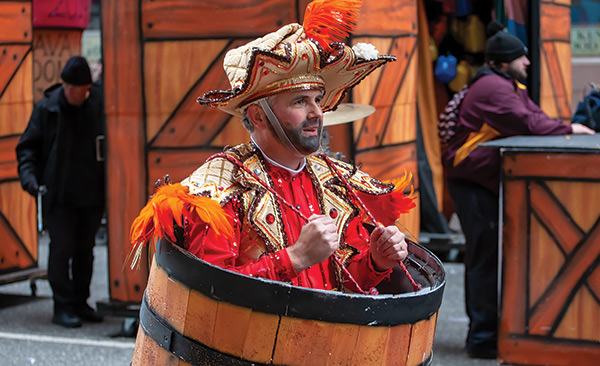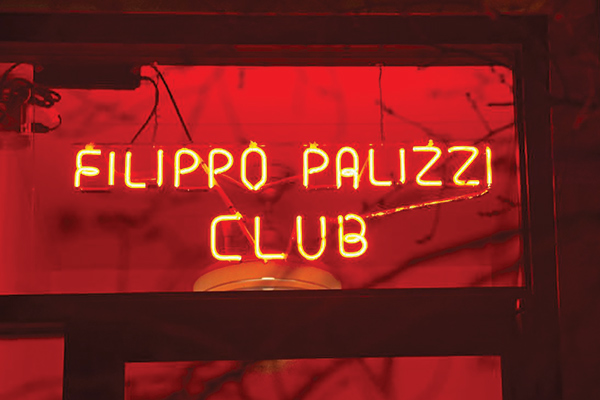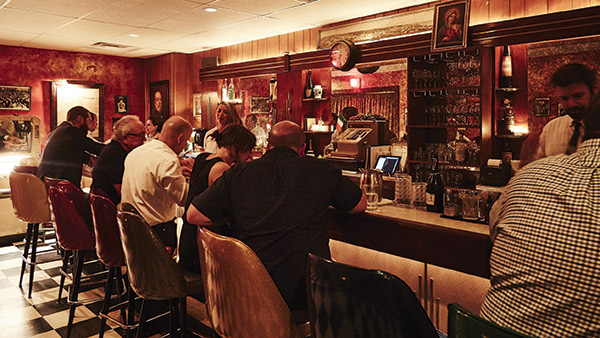Subtotal: $
Checkout-

Save Your Sympathy
-

From “In the Holy Nativity of Our Lord”
-

Digging Deeper: Issue 23
-

Beneath the Tree of Life
-

Sidewalk Ballet
-

The Eternal People
-

Robert Hayden’s “Those Winter Sundays”
-

The Pilgrim City
-

Not Just Personal
-

Editors’ Picks Issue 23
-

Madeleine Delbrêl
-

Covering the Cover: In Search of a City
-

Urban Series (Neighborhood)
-

In Search of a City
-

Readers Respond: Issue 23
-

Family and Friends: Issue 23
-

One Inch off the Ground
-

Re-Mapping Belfast
-

Serving Kings
-

Up Hill
-

City of Bones, City of Graces
-

Small Acts of Grace
-

In the Valley of Lemons

Next Article:
Explore Other Articles:
At a time when sociologists warn of an epidemic of loneliness, a native Philadelphian celebrates her hometown’s patchwork of clubs – the tiny communities that give a city zest and color. Clubs won’t save the world, or your soul. But what would life be without places for joining together in human fellowship?
Already a subscriber? Sign in
Try 3 months of unlimited access. Start your FREE TRIAL today. Cancel anytime.
When I was younger and broker, a day spent wandering around Philadelphia was entertainment enough. Window shopping around Rittenhouse Square or Jeweler’s Row was fine. Better yet were an hour or two wandering from Rittenhouse Square to Society Hill, over to Old City and down to Pennsport, on residential streets without commercial attractions. The stately stone façades of Walnut Street and the snug brick walls of Catharine Street posed an endlessly tantalizing question – what lay behind them? The question became more pressing in the unexpected delight of a gate that perhaps concealed a garden. And best of all were windows: deep, dark pools of possibility, from the depths of which a cat, plant, statue, or silhouette might swim to the surface.
A residential city street seemed something like C. S. Lewis’s wood between the worlds: a traveling place, with portals to a thousand smaller worlds contained therein. I wanted to get inside and know each of them, and at the same time to stay on the city street looking in, suspended on the threshold of uncertainty and speculation.
Even sweeter was when some seeming domicile turned out to have some formal social structure attached to it – a little placard hanging over the door, or a bronze plaque on the wall. THE RAVEN LOUNGE or THE AMERICAN THEOSOPHICAL SOCIETY conjured up new dimensions of possibility.
These were clubs, places where public persons secreted themselves away and made themselves private, without retreating to the full unselfconscious opacity of a domestic house. Philadelphia is a city of clubs, Sandy Smith told me over scotch, and as he is the city’s premier real estate journalist, he’s the man to know. The metropolitan club grew out of the eighteenth-century coffee house, E. Digby Baltzell tells us in Philadelphia Gentlemen, a 1950s ethnography of Philadelphia’s upper class. There’s the Junto, of course, Ben Franklin’s self-improvement and everyday philosophy society. Eighteenth- and nineteenth-century fire brigades, too, presaged modern fraternal organizations; they were as much mutual aid and brawling societies as they were public safety apparata. In Governed by a Spirit of Opposition, Jessica Choppin Roney contends that voluntary and civic associations provided a way for ordinary citizens of a stratified and fragmented city to participate in direct political action and control.
Philadelphia is a small town disguised as a big city.
But the root of the phenomenon may lie deeper. “Philadelphia,” Smith told me, “is a small town disguised as a big city.” Whether a too abrupt separation from the village green and its small-scale society set early Philadelphians in patterns of over-compensation, or whether something in the water just turns Philadelphians into ferocious little partisans of their subcultural territories, the feedback loop is now firmly established.
I talked to Smith in the Pen and Pencil, one of Philly’s Center City clubs. But unlike most of its storied WASP fortresses, the Pen and Pencil possesses a distinctly raffish charm – perhaps appropriate for the nation’s oldest press club in daily operation. Framed by a brick archway and a wrought-iron grille, a neon “P & P” casts its glow out onto Latimer Street. If you’re a member, you can let yourself in. If you’re not, you can rap on the door and hope the bartender hears. The bartender is less harried than most; an elderly man in a waiter’s uniform, he says it’s a good union job. He’s been here a long time.
Inside, it’s all vinyl tabletops and ashtrays around the well-stocked bar. Big stories by famous members hang on the wall. When it gets late, you can help yourself to a hot dog from the boiler. It’s a place for members to sit and work, to grab a quiet drink or smoke of a late afternoon, to meet Larry Krasner for an off-the-record Q and A.
Because it’s a private club, it can stay open past two in the morning. This has given rise to a somewhat dichotomous membership. It’s formally a club for working journalists. After hours, it’s informally a club for area bartenders, waiters, and hospitality workers. Late at night, a concierge from one of the city’s most prestigious private clubs stops by to blow off steam; little worlds and the worlds that they’re built on tangling up at the root system level.
The only downtown club with half as much going on is the Vidocq Society, where a membership limited to law enforcement veterans, scientists, and psychologists solve cold cases together. They don’t respond to my request for comment, afraid, I choose to believe, that I’d out-Marple them all.
Most of the other clubs around Rittenhouse Square tend to have pedigree. The Philadelphia Club serves as the final threshold to upper class society, according to Philadelphia Gentlemen. The Acorn and Cosmopolitan Clubs are women’s equivalents, where wives of Biddles, Cadwaladers, and Morrises lunched in the days when proper society did not dine out publicly.
The Franklin Inn is a little different. It is certainly pedigreed, founded in 1902 and boasting Howard Pyle, N. C. Wyeth, and E. Digby Baltzell himself among its members. Its home is a beautiful colonial revival on South Camac, whose interior has the slightly creaky deliciousness of an old house, perfectly furnished and under-renovated. It hosts impeccable lunches. But while it is and was functionally upper class, the first criterion for membership has always been active participation in or appreciation of the city’s arts and letters scene. And the Franklin Inn prides itself on cultivating a convivially bellicose ethos.
In the same neighborhood lies the Stotesbury Mansion, a magnificent carved stone and wrought iron gilded-age townhouse. In 1925, after all the usual storied-gilded-age-townhouse history, including a cop-diverting mirror maze built during prohibition, the mansion fell into the hands of the Catholic Philopatrian Literary Institute. The “Philo” was formed during the worst anti-Catholic nativist years for the purpose of demonstrating that the Irish could read and love America just as well as anyone else, thank you very much. There must be at least seven or eight different Irish clubs and fraternal organizations in Philadelphia; they range from “nominally ethnic darts league” to “transatlantic Sinn Féin fundraising committee.” My grandfather was in three or four. My brothers joined Roman Catholic High School’s Ancient Order of Hibernians division. But the Philo has the best real estate.

The Union League Club, where the Vidocq Society holds their meetings
Photograph by Karuana G. / Flickr
The city-block-sized second empire building occupied by the Union League is, to my partisan eye, less beautiful than the Philo. But it is probably grander, and certainly bigger. The inside stretches on and on, sweeping marble staircase after sweeping marble staircase, leather armchair after leather armchair, bronze bust after bronze bust. True to its political origins – formed in 1862 to support the Union Army and Republican endeavors – it remains a place for movers and shakers in Philadelphia. Around the 1890s the League let in too many new millionaires for it to belong to the Philadelphia Club’s rarefied heights, but still, if you want to be somebody in Philadelphia, you should probably spend some time at the Union League.
These fine distinctions of upper-classness were unknown to me before beginning this project, and they conjure up a dreary vision of club life: the possibility of endless knocking on yet another exclusive door. It raises the question: Is there something unwholesome about clubs themselves? Is the unselfconscious opacity of the domestic or the open-ended activity of the street (on my way to the League I had to hurry by an SEIU rally and an impromptu open-air bachata lesson) preferable? To escape the miasma and the question let us turn our attention to another set of clubs united around a common objective: the Mummers.
Give Us Whiskey, Give Us Gin
Mummers clubs lie largely in South Philadelphia. But the Aqua String Band clubhouse is in Bridesburg, a working-class neighborhood of single-family homes in the northeast part of the city. Aqua members don’t necessarily live in Bridesburg, but the clubhouse is an important part of the neighborhood. They hand out candy on Halloween and host “beef and beers” for the nearby Polonia Club’s beneficial association.
Inside the clubhouse is a small room with a bar at one end. When I arrived, a small orchestra waited in an open space at the front. Accordions, banjos, saxophones, violins, and drums sat assembled for rehearsal, as did their players. High school students in backwards baseball caps and jerseys; businessmen and firefighters in their thirties, forties, and fifties; and a young and serious salesman for Knights of Columbus insurance were in various stages of goofing around before practice.
Not all of the club’s members are in the band. To be in the band you have to know how to play – high school orchestras are a prime recruiting ground. Or at least you have to be able to learn, because the Aqua String Band is nothing if not democratic. This is a point that the captain, Ken Maminski, impressed on me as one of the biggest misunderstandings about the Mummers.

A mummer in the 2019 parade
Photograph by Bobby Bader Jr. /Flickr
“People think it’s some sort of secret society, that you need to know somebody to get in,” he said over a beer in the clubhouse back garden. “That’s not true. We’re always looking for new members, always ready to welcome somebody new. I know in about ten minutes of talking to someone whether he’ll be a good fit in the clubhouse, and if he is, we’ll find a place for him.”
There are in fact a thousand places for someone who wants to be in the Aqua String Band, each requiring a different kind of skill or creative talent. There are set designers, set builders, and stage hands who keep everything moving on New Year’s Day; dancers, choreographers, bandmasters, and music arrangers; logistical masterminds and accountants keeping track of it all. On New Year’s Day everyone has a role to play, but there’s no distinction within the clubhouse.
What are the Mummers? There are two answers.
The first is that the Mummers are an association of independent clubs, divided into Wench brigades, Comics, Fancies, Fancy Brigades, and String Bands, who stage competitive performances every year in an official New Year’s Day parade in Philadelphia. Mummers go back to the city’s colonial era, when immigrants from Scandinavia, Great Britain, and Ireland brought over the curious old-world custom of costumed house visits and plays around Christmastime. They’d celebrate New Year’s Day by shooting off guns and greeting householders with the rhyme:
Here we stand before your door,
As we stood the year before;
Give us whiskey; give us gin,
Open the door and let us in.
Or give us something nice and hot
Like a steaming hot bowl of pepper pot.
Even then, Mummers were known for being rowdy; the city tried to outlaw them once, to little effect. Finally, in 1901, under the sound principle that if you can’t beat ’em, organize ’em, it launched the first annual Mummers Parade, with judging and prize money.
The other answer is a memory: wrapped in a scratchy wool blanket, hoisted on my dad’s shoulders, jammed into the crowd lining both sides of Broad Street in the biting cold of January. As I remember, it went like this: people jostling, laughing, drinking out of only semi-discreet containers, watched the Mummers strutting down the street. First came the Wenches, burly construction workers with painted faces and flounced skirts and golden slippers (sneakers spray painted gold) twirling parasols; then the Comics and their skits; next the Fancies, unrecognizable and resplendent in sequins and feathers dyed jewel tones, enormous headdresses, like some strange bird-gods from afar. And then came the String Bands, playing the familiar songs – “Oh, Dem Golden Slippers,” “When You’re Smiling,” “I’m Looking Over a Four Leaf Clover” – marching up the street toward the judging station, where they would break into elaborate song and dance routines under the judges’ critical eyes.
The January winds could blow as they liked. A new year was being born, in sequins and color and strings.
The January winds could blow as they liked. A new year was being born, in sequins and color and strings, in the relentless, buoyant, jangling, overwhelming spectacle, and in the incorrigible Mummers’ strut.
What goes into all this spectacle? A year’s worth of time and effort and money, it turns out.
Unlike the New Orleans Mardi Gras Day Parade or the Macy’s Thanksgiving Day Parade in New York, the Mummers Parade has no official sponsorship beyond the city’s prize money. All costs are borne by the respective Mummers clubs – the suits are designed in-house and manufactured by a specialty costume maker. All those sequins and feathers can come to the price of a small house. To raise the money, string bands perform all over the country, traveling to gigs by bus.
But before any of this can happen, themes must be proposed to the theme committee. A theme is debated, discussed, tinkered with, perfected – sometimes for several years – before its adoption. In 2018, the theme was “Lights Out,” a riff on Monsters, Inc. After the committee officially votes on a theme, it’s time to figure out how to make it a reality. The captain’s son showed me a software program he uses to model the set and placement transitions for each part of the performance. Across the street, in the rec center, Mrs. Maminski is teaching the dancers her choreography. (The Aqua club is formally all male but functionally a family clubhouse; various other clubs are co-ed. Since it’s easy to join the club that suits your preferences, there seems little contention over it.)
The club’s nature as family affair is fortunate, given the amount of time it demands. Maminski was ready to retire, in fact, until his son expressed interest in joining. Now all four Maminskis argue over the dinner table about how a dance should go, where a group should be placed, or which part of the arrangement should come first.
Nor is the Maminskis’ all-consuming interest in perfecting the performance unique to them. After practice, the band hangs around, ordering pizza and watching “mum tapes” – recordings of previous performances. They can identify a misstep, a particular performer underneath layers of face paint and costuming, a particular area where they’ve improved. “It’s so creative,” one member told me when I asked what he gets out of these long Tuesday nights. He’s right. Drill down far enough in your quest to understand the Mummers, and you get to the pure performer, who makes and acts because that is what humans do.
Excellence in this arena doesn’t need much further rationalization. And the Aqua club is pursuing excellence, steadily rising through the rankings bestowed by the Mummers Parade judges every year.
The Mummers are fiercely competitive. Maminski has friends and relatives in various other clubs, he said, “except on New Year’s Day.” On New Year’s Day you hope that everybody between you and first place falls down and sprains their ankle.
The Aqua club is home. “We’re brothers,” Maminski said. He likes knowing that if his son is going through something that’s hard to share with dad, he can talk to the other guys at the club. He likes coming back to Bridesburg on New Year’s Day, delirious with the post-parade high, and seeing the whole neighborhood turn out to welcome them. This year, he knows, they’ll come back to Bridesburg with the trophy; this year’s their year. I believe it.
The House That Jazz Built
The Mummers are not the only Philadelphia institution founded on a love for performance. The Clef Club, several blocks down from the Union League on South Broad, is informally known as “the house that jazz built.” In the 1930s, when black musicians had a hard time finding a place in white unions, musician Frankie Fairfax organized Local 274 for them, under the auspices of the American Federation of Musicians. Local 274 also had a performance space and social club for entertainers to relax, enjoy their craft, and meet other musicians; this space eventually became known as the Clef Club. John Coltrane, Dizzy Gillespie, and Nina Simone were just a few of its famous members.
In the 1960s, desegregation of the unions became a federal mandate. Unfortunately, this often meant that black unions were assimilated into white ones, losing their charters, their real estate, and their financial assets in the process. Local 274 resisted as long as it could, arguing in court that since, unlike the white unions, it had never discriminated by race, it had always been in fact an integrated club. It lost; but by spinning off the Clef Club as a separate entity, it was able to keep its assets, and more importantly, its independence.

Performer at the Clef Club, November 2019
Photograph from clefclubofjazz.org
Now the Clef Club is a jazz performance space with a strong musical education program. Lovett Hines, Clef’s music education director, talks about young musicians who have come up through the club the way a proud grandfather talks about his children: remembering them all by name, showing you pictures, detailing every accolade they’ve earned. And they are an impressive bunch, playing everywhere from Carnegie Hall to Beyoncé’s Super Bowl halftime performance. And when they come back to play at the club, the bar is there for them the way it was for Clara Ward and Philly Joe Jones – to relax, to reminisce, to get to know the up-and-comers in a new generation of Philadelphia jazz.
Farther down Broad Street, past where any respectable clubman would stray when the Union League was first built, sits a low, square brick building, wedged tightly between its neighbors on a residential street. There is nothing to indicate that this is not somebody’s modest home, except the unobtrusive red neon lights over the transom: Filippo Palizzi Club. There is nothing to indicate that this is one of the most sought-after dinner seats in Philadelphia, except the line of people at five p.m. on a Thursday, quietly waiting for the doors to open.
Families are liable to have a matriarch in the neighborhood whose Sunday gravy is the gravitational center of home.
South Philadelphia in its early days was home to the poor, the immigrant, and the tough customer. Now it is home to everyone: the post-college up-and-comer out for a good time, sharing a house with six of his friends; the girls I went to school with – Donnas, Giannas, Tinas, Reginas – their brothers at Roman Catholic High School for Boys, and their nonnas; the wealthy couples in Queen Village with four hundred grand to drop on a townhouse for themselves and two dogs; the sturdy pockets of Irish in Pennsport; the new immigrants whose status is yet untinted by rose-colored nostalgia. From the mid-nineteenth century onward, South Philly welcomed Italian and Irish immigrants en masse, as well as African Americans moving northward in the great migration. Lately it has welcomed Mexicans, Hondurans, Cambodians, and Vietnamese, to name only a few. Also lately it has welcomed – and not welcomed – gentrifiers. You can get a three-bedroom brick-row home in Lower Moyamensing for $175,000; new construction can go for $300,000. In Queen Village, where South Philadelphia kisses Society Hill and Center City, homes are going for four hundred to eight hundred grand.
All this is to say that South Philadelphia is changing and remaining. The prices go up, but a working family can still buy a home. Some families move out to the suburbs; others stay, and new ones move in. Expensive new construction has not overwhelmed the squat brick homes on tightly packed streets, and the skyline is still low and flat and netted with drooping wires. You can sample some of the most vaunted offerings in Philly’s restaurant scene, or get a slice and a beer for under five bucks. Families stay in the neighborhood for a hundred years or for ten, bickering over parking and bringing each other Christmas cookies. In high school it was the best place to trick-or-treat for teenagers politely determined to get theirs, and I expect it still is.
Palizzi Club
Above all, what has remained is the sense of the place as an Italian-American holdout. Families who moved out to the suburbs are liable to have a matriarch in the neighborhood whose Sunday gravy is the gravitational center of home. Italian flags flutter on every corner. Whatever restaurants move in and out, the culinary base remains the same: roast pork sandwiches on Amoroso rolls, Cappucio’s meats, DiBruno Brothers’ fine grocery.
It is one of the curious dynamics of human self-narration that a national consciousness often emerges from or enforces the disintegration of more local identities. The “Italian character” of South Philly is something seen in retrospect, when time and assimilation have both done their work. In fact, immigration was not from any generic Italia: it was primarily from specific towns within Abruzzo, Campania, and Sicily.
When the Palizzi Club first came into being, immigrants were so many and so recent that distinctions were possible on a microscopic level. The club was originally founded as a social hub and mutual aid society for neighborhood residents from the Abruzzan town of Vasto. (The club is named for one of Vasto’s prominent citizens, a painter named Filippo Palizzi.)
“It was a social club,” Joey Baldino told me on the phone, “but it was more than that. People took care of each other. If you got sick, if your house burned – the club would take care of you.”
Mutual aid was an absolute necessity in those days, when recent immigrants faced both poverty and discrimination, and the church was run almost entirely by the neighborly but mistrusting Irish. Over the years, the club became something of a bellwether for the changes in South Philly. Mutual aid became less necessary, and the club began expanding its membership – from Vasto to Abruzzo, from Abruzzo to southern Italy, and from southern Italy to Italy, full stop.
The club remained a place for the neighborhood to meet, have a drink, or throw darts on Sunday after church. Eventually, its presidency and de facto proprietorship passed into Baldino’s family. He remembers a childhood of celebrations within its walls. For first communions and birthdays, weddings and funerals, attendees would gather to celebrate or mourn in the long, narrow clubhouse at the glossy wooden bar which the club’s first members inaugurated in 1918.
There are clubs like this all over Philadelphia and its suburbs, like the Palombaro Club of Ardmore, down the street from Carlino’s Specialty Foods and Milano’s Auto Repair, where on most summer days you can find a few older men playing bocce in the little courtyard, and a few more drinking Yuengling or amaros in a conspicuously unrenovated bar. Most weekends the hall will be rented out for a wedding. They have never regained the centrality and the prestige they had throughout the first half of the twentieth century, but they are important in the lives of the core they still serve, and they hang on.

The iconic sign over the entrance of the Filippo Palizzi Club
Photograph from the Philadelphia Inquirer
But what separates the Palizzi Club from all these with whom it shares a common background is an accident of history, or fate. It’s Joey Baldino.
Baldino is a celebrated chef and restaurateur. His main restaurant, Zeppoli, a Collingswood, New Jersey homage to the Sicilian food he grew up with, appears regularly on best-of lists in the greater Philadelphia region and beyond. When word got out that he was, as Philadelphia magazine put it, “opening a members-only restaurant in Philadelphia,” so many people flooded the new applicants’ site that it temporarily shut down.
But it’s not quite accurate to say that Baldino was “opening” a members-only “restaurant.” He did not revive the club after long disuse, nor acquire and design it as a concept. He took it on as a family trust.
When Baldino’s uncle, the club’s then-president, fell ill, he had two choices: shut the club down, or pass it on to a new generation. He asked Joey if he’d like to take over. Joey accepted. He redid the electrical and plumbing, filled the menu with family recipes and the bar with a judicious selection of classic cocktails and imported amaros, and opened up an otherwise unchanged clubhouse to new membership. The response has been overwhelming, and perhaps at times bemusing.
Media coverage has described the Palizzi Club as a “speakeasy-style restaurant” but, “It’s not a speakeasy. It’s not a concept,” Baldino said. The club’s much-noticed decor is not perfectly executed mid-century modern; it’s just the place he remembers as a kid at a moment when fifties paneling and vinyl happened to be in fashion. The deceptively homey façade and quiet residential location aren’t there to manufacture a mystery, but because they always have been. Concepts are projected outward onto the public; Baldino’s gambit aims, tentatively, to draw people into a private vision.
“It’s always been a neighborhood club, and that’s what I want it to be. Only now the neighborhood is hipsters as well as the old-timers.” So Palizzi caters to them both.
Palizzi’s famously strict rules are in place to keep it functioning primarily as a social club, not a hot spot. Cash only, dress nice, no phones out, no pictures, keep it down for the neighbors, no reviewing. Members enforce the rules amongst themselves, Guido Martelli, the head waiter, told me. “We have a lot of members here who are regulars.”
You can hear the love in Baldino’s voice, the pride in the popularity of his family’s club, the eagerness to keep its traditions alive.
They’ll come in on a quiet Sunday and hang out at the bar, both original club members and neighborhood residents who joined when Baldino opened up membership. They’ll nudge someone and tell them to put their phone away if necessary. “The club means a lot to people, and they want to keep it the way it is,” Martelli said.
This was also the rationale for closing new membership when the club proved more popular than Baldino could have imagined. Of course, exclusivity enforced with sincerity is kerosene poured on the fires of public demand. It’s easy to imagine a cynical story, with a chef at home enough in two different worlds to arrange a calculated marriage. But talking to Baldino, it’s impossible to think that’s the correct read. You can hear the love in his voice, the pride in the popularity of his family’s club, the eagerness to keep its traditions alive; most tellingly, you can hear a small note of care, that having opened up something so personal to a wider public, he might find it misread, misunderstood, misused.
It’s a delicate situation: to persist through another century, the club would have to change, and it’s a piece of stunning good fortune that a restaurateur of Baldino’s caliber was ready in the wings. But Baldino’s gifts come with the dangers of celebrity; the rules, the rituals, and the limits are a way of managing that danger, of threading the needle between oblivion and generic fashionability. If the Palizzi Club was a long-time bellwether for the changes in South Philly, it’s now a palimpsest for Philadelphia as a whole; having weathered the dangers of disappearing entirely into the past, it’s now trying to avoid disappearing entirely into the future.
I think it’s succeeding, but I won’t tell you precisely why. That would be too much like a review, and I promised not to review. And I will admit, with a bit of a brag, that when I took my leave there was a membership card waiting for me, stamped with the Vasto crest. It will be there for me when I next come home – to Philadelphia, to the small town pretending to be a big city, to the worlds within worlds, to my city of clubs.

Inside the Palizzi Club
Photograph by Alex Lau. Used by permission.
Already a subscriber? Sign in
Try 3 months of unlimited access. Start your FREE TRIAL today. Cancel anytime.

































